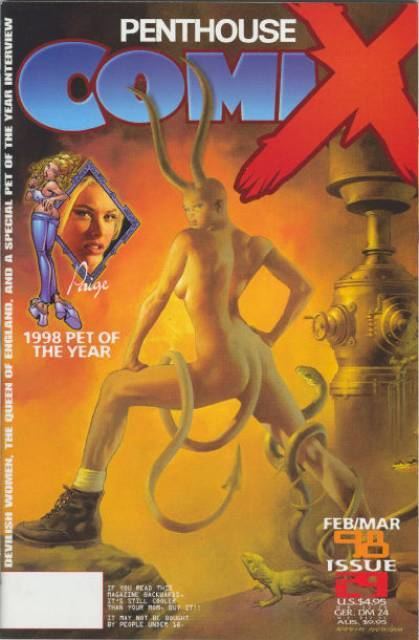Publisher Penthouse | Number of issues 32 | |
 | ||
Publication date May/June 1994–July 1998 Artist(s) Adam Hughes, Garry Leach, Kevin Nowlan, Mike Harris, Arthur Suydam, Jordan Raskin, Horacio Altuna, Milo Manara, Richard Corben, Tony Salmons, Bart Sears, Gray Morrow Similar Wicked Wanda, Epic Illustrated, Maze Agency, Fairest, Click | ||
Penthouse Comix was an American mass-market, magazine-sized comic book, published by Penthouse International/General Media Communications from spring 1994 through July 1998. Founded and initially edited by George Caragonne and Horatio Weisfeld, it ran 32 issues plus one special edition. Foreign versions of Penthouse Comix continue to be published.
Contents
1995 penthouse comix
Publication history
Penthouse Comix began after publisher Bob Guccione agreed to a budget that was designed to cherry pick top art talent from competitors. This resulted in Penthouse Comix offering a per-page art rate to freelancers of $800, the largest ever established as a standard for comic book line art.
After a three-issue installment trial run as an insert feature in Penthouse Magazine, Penthouse Comix was expanded into a stand-alone magazine. The first issue, a 96-page, color, glossy magazine, appeared in spring 1994. It featured work by Adam Hughes, Garry Leach, Kevin Nowlan, Mike Harris, Arthur Suydam, Jordan Raskin, Horacio Altuna, and Milo Manara. Subsequent issues contained work by comic book artists such as Richard Corben, Tony Salmons, Bart Sears and Gray Morrow. Early issues eschewed hardcore sex in favor of soft-core nudity and satiric humor.
Sold on newsstands, the periodical debuted in a squarebound magazine format 27.5 centimeters high and 20.7 cm wide. With issue #11, the size was reduced to 26.7 cm high and 20.4 cm wide. From issue #26 to the end of its run, Penthouse Comix was published at standard modern comic-book size, with saddle-stitching, card-stock covers, and glossy interior pages. Issues #6-7 were published in both a magazine-size newsstand edition and a comic-book sized direct-market edition for sale in comic-book stores.
Two additional titles were later added to the line: The seven-issue Men's Adventure Comix (cover-titled Penthouse Men's Adventure Comix) (April/May 1995 - April/May 1996), and the three-issue (March/April 1995 - Oct./Nov. 1995) Omni Comix, the latter a companion to the science magazine Omni.
Editor-in-chief George Caragonne, who was developing a history of erratic behavior, purged managing editor Horatio Weisfeld during the production of Penthouse Comix #4. After Weisfeld's departure, some top-line artists began abandoning assignments, to be replaced by lesser talents, while overall quality and sales declined.
In 1995, Caragonne was accused of embezzlement by Penthouse, was fired, and later committed suicide.
General Media then seized control of its comics-related publishing from the deceased Caragonne's packaging company, and installed Dave Elliott as editor. The Penthouse Comix line was whittled to the original magazine. Elliott edited the remainder of the magazine's run, largely printing sub-par material which had been contracted by Caragonne. General Media went bankrupt a few years later.
Censorship
In June 1994, Canadian authorities warned that they would prohibit distribution of Penthouse Comics issue #2 (July/August 1994) because of "six panels of comics dealing with the subjugation of women and other sexual themes."
Some European countries also altered a story that featured Adolf Hitler (under laws which prohibited depiction of the Nazi leader). Editor Carragonne then went out of his way to inflame the issue by prominently featuring a swastika on the cover of Penthouse Comix #3. Although the cover had clearly been modeled on 1960s men's pulp magazine covers (which routinely featured Nazi villains), for foreign markets the swastika was altered to become an "X," and depictions of Hitler's head and swastika ring (in one story written by Caragonne) were replaced with a smiley face.
Merchandising
In 1996, RC Cards issued a boxed set of Penthouse Comix trading cards. The 27 standard cards were accompanied by a chase card of Penthouse Pet Emerald Heart; a 1,000-limited-edition Alphonso Azpiri autograph card; and an Adam Hughes Hericane promotional card. The set included art by Hughes, Julie Bell, Ernie Colón, Glenn Fabry, Frank Frazetta, Mark Texeira, Boris Vallejo, and others.
Foreign editions
Foreign versions of Penthouse Comix initially reprinted the material from the American magazine, but later began contracting for new material by top non-American creators, such as Jordi Bernet and Enrique Sánchez Abulí. Foreign editions of Penthouse Comix continued publishing long after the American version ceased. Overseas editions of Penthouse Comix have been published in England, France, Italy, Germany, New Zealand, Australia, South Africa, and Mexico. The Spanish edition of Penthouse Comix celebrated its 100th issue in 2010.
